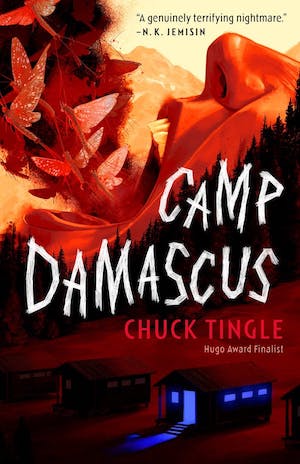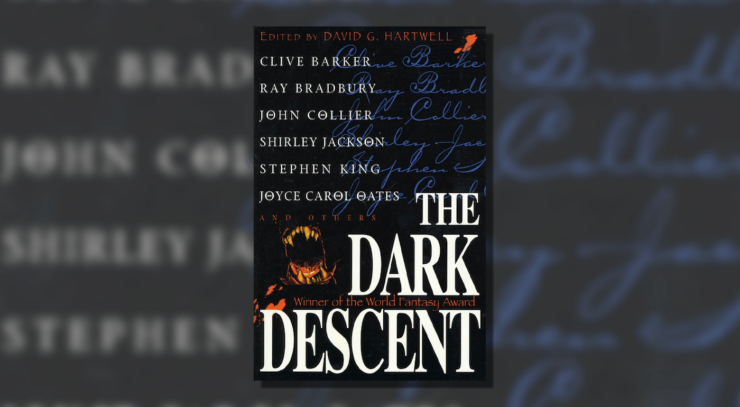Hello dear dissectors and welcome back to Dissecting The Dark Descent, where we lovingly delve into the guts of David Hartwell’s seminal 1987 anthology story by story, and in the process, explore the underpinnings of a genre we all love. For a more in-depth introduction, here’s our intro post.
“There’s A Long, Long Trail A-Winding” by Russell Kirk is perhaps the clearest example of “moral-allegorical” horror (per Hartwell’s “three streams”) in The Dark Descent. Kirk, a devout Catholic and literary critic who wrote ghost stories in the older tradition (he personally name-checked such luminaries as Dickens and M.R. James), even says as much in his essay about his work, “A Cautionary Note on the Ghostly Tale.” His view on ghost stories was that they depict spiritual encounters with souls existing within a larger and specifically religious framework, and are inextricable from such.
Because of this, “There’s A Long, Long Trail A-Winding” is a story where the supernatural is used as conveyance of a specific moral message, which Kirk finds far more interesting than telling a ghost story. The tale of Frank Sarsfield’s stay in a haunted mansion has a specific point that it wishes to explain to the reader. The story also very clearly demonstrates that Kirk understands his specific version of a ghost story, and can execute it relatively well. There’s a wintry atmosphere to the tale, and the encounters with ghosts are (until the end) eerie more than terrifying, with an overall theme of redemption running throughout. Unfortunately, “There’s A Long, Long Trail A-Winding” also shows that if an author gets in their own way and worries too much that the readers won’t get the message they’re trying to get across, it will derail the story further and further as they labor to get the point across to the detriment of the tale itself.
Buy the Book


Camp Damascus
But first, as always, we begin with a quick summary of the story: Frank Sarsfield, an ex-convict drifter with the build of a Viking berserker and the heart of a devoutly Catholic pacifist poet, finds himself lost in a blizzard and seeks shelter in an abandoned town. At the edge of town, he finds a mansion fully stocked with supplies, well-kept enough to last him the winter. As he explores his new temporary home, Frank finds remnants of the Anthonys, the family that once lived in the house, and their ex-convict hired hand, also curiously named Frank. As he uncovers the past of the Anthony family, doors move on their own, he hears footsteps and voices just out of sight, and weirdest of all, he has dreams and memories of being the earlier Frank, the family’s hired hand. It’s clear Frank is in the house for some purpose, but what? And what happened in the Anthony mansion?
What makes “Long, Long Trail” frustrating is that it’s an amazing ghost story. There’s a compelling atmosphere and an eerie desolation to the ghost town where Frank tries to last out the blizzard. Kirk also adds some lovely interplay with Frank’s dreams, memories, and the history of the house and its hired hand. Throughout, two possibilities—that Frank’s a ghost remembering his life as he haunts the mansion in the blizzard, or that the house is warping Frank’s memories and slowly incorporating him into its history—are discussed in detail with a certain unnerving ambiguity. Frank’s even sympathetic enough that you understand that this tortured man, drifting through life like a ghost, simply wants to do the right thing despite his challenging circumstances. If that was the whole of the story, it would be a good one. There’s just one small issue with the whole thing.
In “There’s A Long, Long Trail A-Winding,” Kirk lets his sermon get in the way of a good story. He’s so hell-bent (pun very much intended) on discussing the Catholic implications of Frank’s life, predicament, and eventual redemptive act that the narrative gets repeatedly interrupted by the blaring horns of religious allegory. Frank openly tells people that his sins (mostly petty, non-violent crimes) mean he is destined for Hell and he wishes to perform a “Signal Act,” something that redeems his soul to God. The story’s ending leans hard into Frank’s final moments as a redemptive act freeing him from sin. Clearly, Kirk’s principal aim was to provide moral education in the Catholic vein. Taking that as intended from the author, it almost feels like Kirk doesn’t have confidence in his own message and feels a need to ensure the audience understands it completely. Further confusing the issue, the story is mostly separate from Kirk’s polemic on the nature of redemption (the moral bit of the allegory is carried out in a long letter from Frank to his sister), and just underscores that Kirk himself had a lack of faith (again, pun very much intended) in his own allegory.
It’s a difficult path for a writer to walk. If you write a good enough story but bury the allegory, everyone will miss the point the writer is trying to make and instead focus on the fiction itself (as King, Bradbury, Le Guin, Leckie, and countless others have learned). If you write the story with the elements you wish to convey front and center (something plenty of religious authors have dealt with—not least of all C.S. Lewis), your audience may roll their eyes and walk away in frustration, because then you’re just preaching. Crafting a strong allegorical message requires both that you have faith enough in the material not to start lecturing the audience, and enough confidence in the work that if people don’t get it, there’s still value to the telling. The beauty of art is that it’s subjective and everyone will take away their own interpretation. A writer just has to hope their work is good enough and their message strong enough that what they want to say shines through. This is something all artists struggle with, and something artists will have to struggle with as long as we continue to create and discuss art.
It’s a shame: Kirk’s a decent writer, and definitely one who understands the ghost story in concept and history, despite his narrow views and shortcomings when it comes to the form. It’s clear to see why Hartwell chose to include his work, and again, Hartwell’s instincts were great in picking this story for this collection. It’s a work with ties to the Gothic and the wintry tradition of “ghost stories at Christmas” with its unnerving old dark house and a deep sense of heart. Russell Kirk is clearly capable of telling a fantastic story, and the good parts of “Trail” are deeply compelling. Unfortunately, Kirk’s inability to let that story shine on its own means that it ultimately fails to live up to the promise of its good points.
But that’s why we discuss these things. Does Russell Kirk get in his own way, or is Frank’s haunted house encounter less preachy than it seems at first? Is it more important that you get the point of your story across, or is it all right if there’s room for interpretation and ambiguity in a good story, even if it means readers might not get the intended message? Either way, “There’s A Long, Long Trail A-Winding” remains a compelling entry into Hartwell’s horror canon.
Please join us in two weeks when, in an effort to not spend too much time going over points numerous people made previously, I attempt to speed-run through the anthology’s engagement with H.P. Lovecraft’s work.
Sam Reader is a literary critic and book reviewer currently haunting the northeast United States. Apart from here at Tor.com, their writing can be found archived at The Barnes and Noble Science Fiction and Fantasy Book Blog and Tor Nightfire, and live at Ginger Nuts of Horror, GamerJournalist, and their personal site, strangelibrary.com. In their spare time, they drink way too much coffee, hoard secondhand books, and try not to upset people too much.










